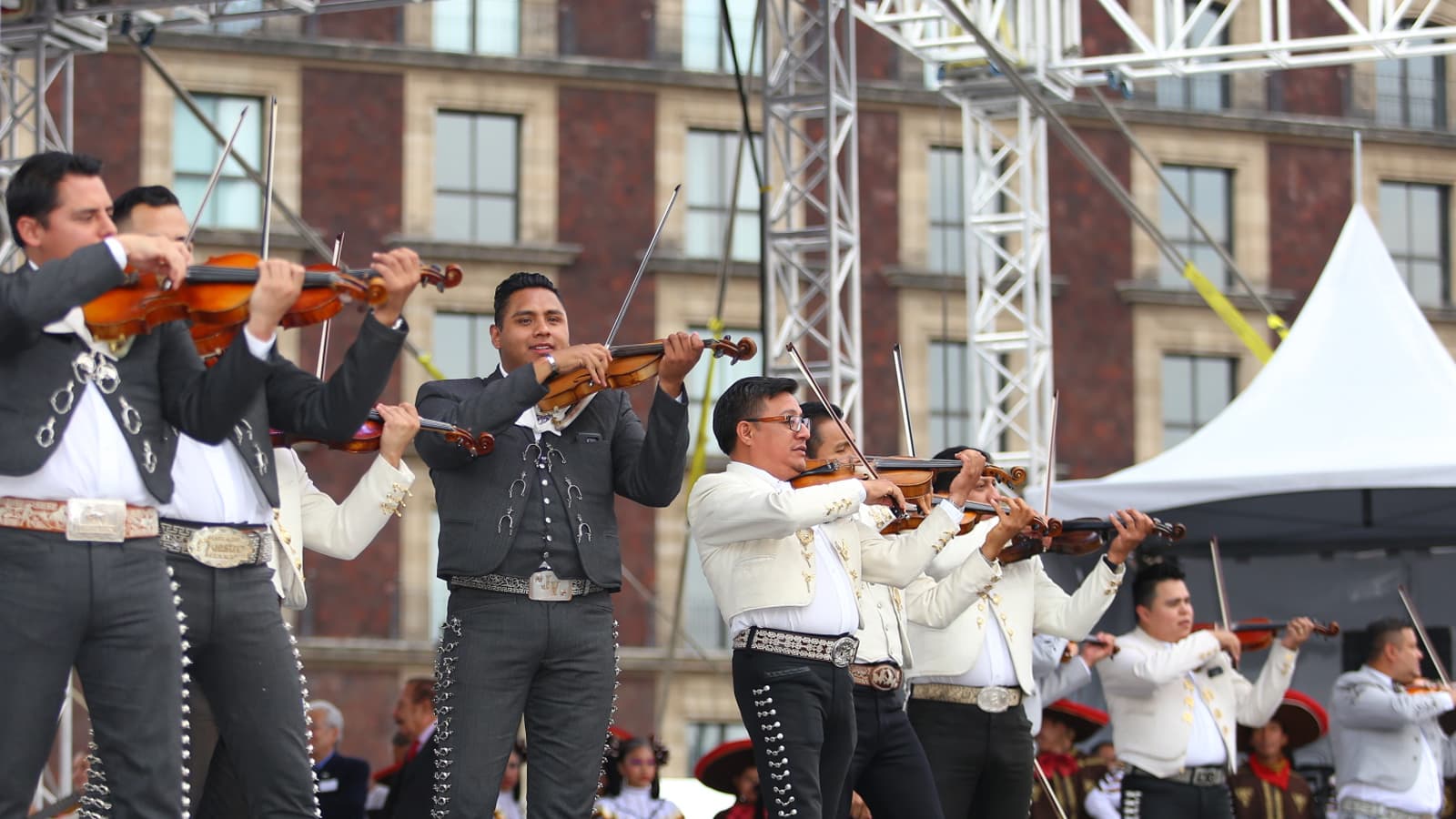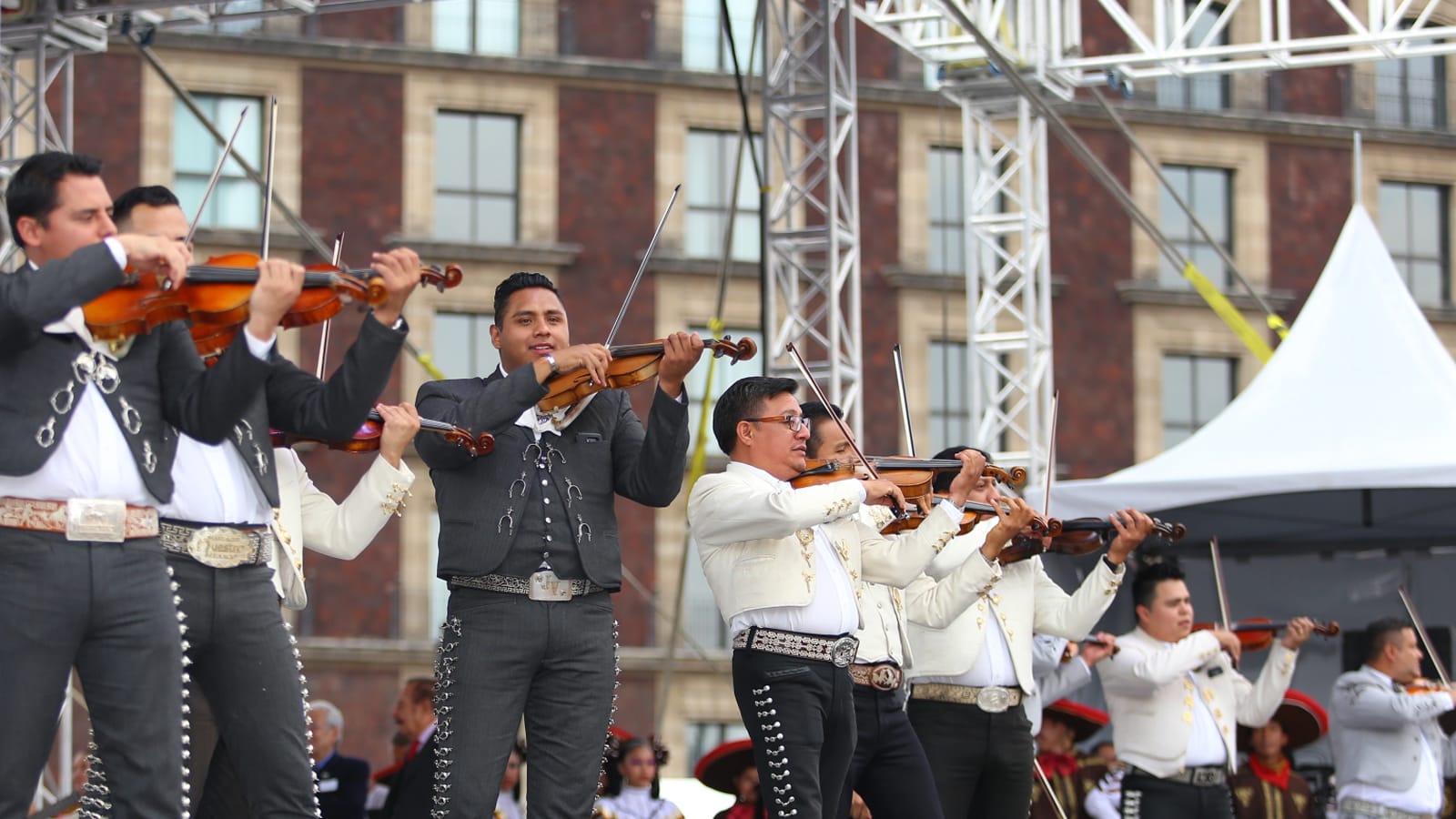
Gobierno CDMX - Wikimedia Commons
Western classical instruments were first brought to Mexico by the Spanish conquistadors, who began teaching indigenous people. Mariachi first emerged in the late 1700s or early 1800s in west-central Mexico. Initially, mariachi was solely an instrumental genre with regional sones, but it soon incorporated vocal elements. By the mid-1800s, mariachi bands consisted of single violin, harp, and guitar, but gradually, other instruments were added as bands sought to have larger rhythm sections. The mariachi rhythm section grew to contain the guitarrón, a large bass guitar, a traditional Spanish guitar, and a higher-pitched rhythm guitar called the vihuela. The melody section was also expanded, using multiple violins and trumpets, in addition to the harp, which plays both the melody and rhythm parts. It wasn’t until the 1930s that trumpets were added to the mariachi band, apparently so the music could be better heard over the radio. During the 1930s, mariachi music also gained worldwide exposure during the golden age of cinema. Mariachi music has borrowed from and absorbed many styles over its history, including Cuban boleros and other popular dance styles. Here are just a handful of times mariachi music and classical music came together:
José Hernández (b. 1958) and Mariachi Sol de México, La Música (“Music”)
In the groundbreaking 2012 album La Música, Mariachi Sol de México, led by José Hernández, combines symphonic textures with vibrant mariachi melodies. Hernández is a composer, arranger, engineer, mixer, and musician, and has worked with many notable musicians. Hernández was the vocal coach for Linda Ronstadt on her 1987 double-platinum album Canciones de Mi Padre, a tribute to Ronstadt’s Mexican roots. The title track on his La Música is a testament to Hernández’s skill as an orchestrator. It begins with a sober string introduction that soon blossoms into a technicolor wonderland reminiscent of a 1950s film score when the Mariachi band joins forty seconds into the track. Listen to “La Música”:
La Música - Mariachi Sol de Mexico de Jose Hernandez
José “Pepe” Martínez (b. 1941), Cruzar la Cara de la Luna (“To Cross the Face of the Moon”)
With music by mariachi star José “Pepe” Martínez and libretto by Leonard Foglia, Cruzar la Cara de la Luna was commissioned by the Houston Grand Opera in 2010 to mark the anniversaries of Mexican Independence and revolution. Conceived as a work that would fuse mariachi and opera, it tells the story of three generations of a Mexican American family separated by the United States border. Laurentino has moved to America to find work, leaving behind his son and wife in Michoacán. Many years later, as he lies dying, he contemplates the meaning of family and home as dark secrets about his past are revealed. Mariachi music is woven throughout the score: the band performs from the back of the stage as the cast sings and dances before them. Here, Mariachi Vargas de Tecalitlán appears onstage to perform “En Fragiles Alas” (“On Fragile Wings”) with the Houston Grand Opera:
Houston Grand Opera's "Cruzar la Cara de la Luna"
Blas Galindo (1910–1993), Sones de Mariachi
Born in San Gabriel (now Venustiano Carranza), Blas Galindo was a Mexican composer of Huichol Indian descent. At 19, he learned to play the organ by ear and picked up the clarinet a year later. He studied with prominent teachers including Carlos Chávez and Aaron Copland, forming the “Group of Four” with fellow composers José Moncayo, Daniel Ayala, and Salvador Contreras to promote Mexican nationalist music. Sones de Mariachi was one of several pieces on the program at Galindo’s New York debut at a concert at the Museum of Modern Art. It became his most popular work. Brimming with lively melodies, Sones de Mariachi feels like walking through the soundscape of Galindo’s Mexico City. Listen to the National Symphony Orchestra of Mexico under the baton of Juan Carlos Lomónaco as guest conductor:
Sones de Mariachi - Blas Galindo
Juan Pablo Contreras (b. 1987), Mariachitlán
Emerging composer Juan Pablo Contreras, a native of Guadalajara, seamlessly combines Western classical and Mexican folk music. His Latin Grammy-nominated Mariachitlán, or “Mariachi Town,” is a light-hearted work that pays homage to the state of Jalisco, the birthplace of mariachi music. The piece takes place during a mariachi battle as bands compete for the crowd’s favor, at one point even attracting the attention of a police officer who uses his whistle to break up the commotion. Contreras cleverly imitates the sound of the vihuelas (small guitar) and guitarrón (bass guitar) using the high strings and basses respectively, suffusing his music with the rhythms of mariachi.
Juan Pablo Contreras - Mariachitlán
José Moncayo (1912–1958), Huapango
Mexican pianist, percussionist, and composer José Moncayo is one of the main exponents of Mexican nationalist music and was a member of the influential “Group of Four.” Huapango, one of Moncayo’s most famous pieces, was based on folkdances Moncayo heard while traveling in the Veracruz region. These folk huapangos—el siquisirií, el balajú and el gavilán—would have often been played by mariachi bands. The word “huapango” derives from the Nahuatl word “cuauhpanco” meaning “on top of the wood,” in reference to a wooden platform upon which dancers performed. Listen to Gustavo Dudamel and the Simón Bolívar Symphony Orchestra of Venezuela play Huapango:
José Pablo Moncayo: Huapango







